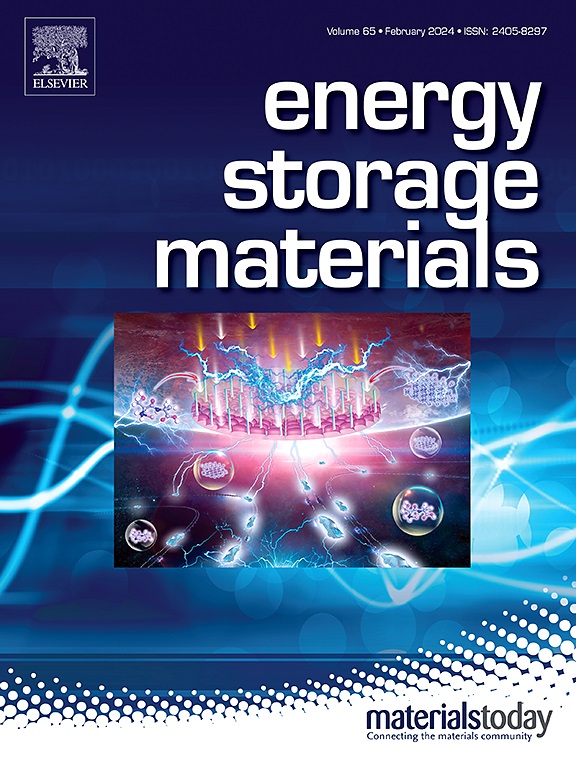A bioinspired flexible hydrogel electrolyte with β-sheet–directed interphase for dendrite-free Zn metal batteries
IF 20.2
1区 材料科学
Q1 CHEMISTRY, PHYSICAL
引用次数: 0
Abstract
Aqueous zinc-ion batteries (AZIBs) have attracted growing attention due to their intrinsic safety, low cost, and environmental compatibility. However, challenges such as zinc dendrite formation, electrode passivation, and parasitic side reactions continue to impede long-term cycling stability. Inspired by conformational transitions in natural proteins, we propose a biomimetic interfacial engineering strategy by introducing silk fibroin (SF) into a hydrogel electrolyte. Upon solvent induction, SF undergoes a structural transition from α-helix to β-sheet, forming a dense, ionically conductive interphase on the Zn anode. The ordered β-sheet network, enriched with Zn-affinitive polar groups, modulates Zn2+ solvation, guides deposition along the (002) crystal plane, and suppresses dendrite growth and side reactions. Density functional theory (DFT) and molecular dynamics (MD) simulations reveal the mechanism of solvation structure reconstruction and interfacial stabilization. Benefiting from this design, the β-SF hydrogel electrolyte enables stable Zn plating/stripping over 2500 hours at 1 mA cm−2, while the Zn//MnO2 full cell retains 93.8 % capacity after 1500 cycles at 1.0 A g−1. Moreover, the fibrous and flexible configuration exhibits excellent mechanical durability and device compatibility. This work presents a protein-based interfacial strategy driven by conformational regulation, offering a new pathway toward high-performance, durable, and flexible AZIBs.

用于无枝晶锌金属电池的具有β-薄片导向界面相的仿生柔性水凝胶电解质
水性锌离子电池(AZIBs)因其固有的安全性、低成本和环境相容性而受到越来越多的关注。然而,锌枝晶形成、电极钝化和寄生副反应等挑战仍然阻碍着长期循环的稳定性。受天然蛋白质构象转变的启发,我们提出了一种将丝素蛋白(SF)引入水凝胶电解质的仿生界面工程策略。在溶剂诱导下,SF从α-螺旋结构转变为β-片状结构,在Zn阳极上形成致密的离子导电界面相。富含zn亲和极性基团的有序β-片网络调节Zn2+的溶剂化,引导(002)晶面沉积,抑制枝晶生长和副反应。密度泛函理论(DFT)和分子动力学(MD)模拟揭示了溶剂化、结构重建和界面稳定的机理。得益于这种设计,β-SF水凝胶电解质可以在1 mA cm−2下稳定镀锌/剥离2500小时,而在1.0 A g−1下,Zn/ MnO2充满电池在1500次循环后保持93.8%的容量。此外,纤维和柔性结构表现出优异的机械耐久性和器件兼容性。这项工作提出了一种由构象调节驱动的基于蛋白质的界面策略,为高性能,耐用和灵活的azib提供了新的途径。
本文章由计算机程序翻译,如有差异,请以英文原文为准。
求助全文
约1分钟内获得全文
求助全文
来源期刊

Energy Storage Materials
Materials Science-General Materials Science
CiteScore
33.00
自引率
5.90%
发文量
652
审稿时长
27 days
期刊介绍:
Energy Storage Materials is a global interdisciplinary journal dedicated to sharing scientific and technological advancements in materials and devices for advanced energy storage and related energy conversion, such as in metal-O2 batteries. The journal features comprehensive research articles, including full papers and short communications, as well as authoritative feature articles and reviews by leading experts in the field.
Energy Storage Materials covers a wide range of topics, including the synthesis, fabrication, structure, properties, performance, and technological applications of energy storage materials. Additionally, the journal explores strategies, policies, and developments in the field of energy storage materials and devices for sustainable energy.
Published papers are selected based on their scientific and technological significance, their ability to provide valuable new knowledge, and their relevance to the international research community.
 求助内容:
求助内容: 应助结果提醒方式:
应助结果提醒方式:


